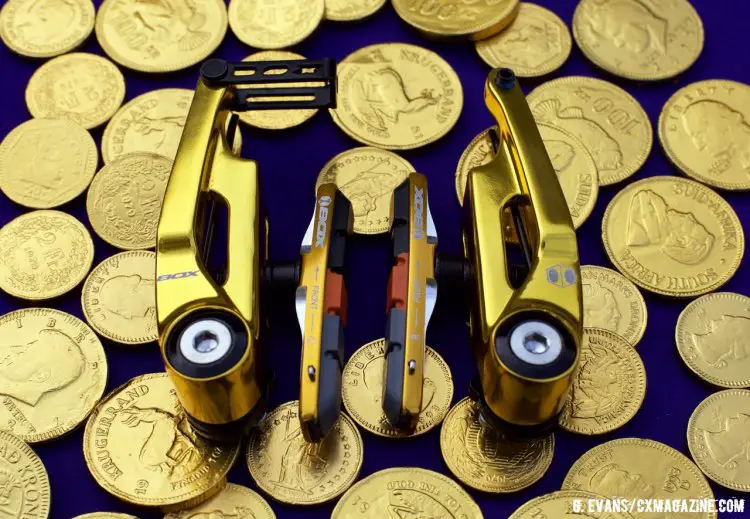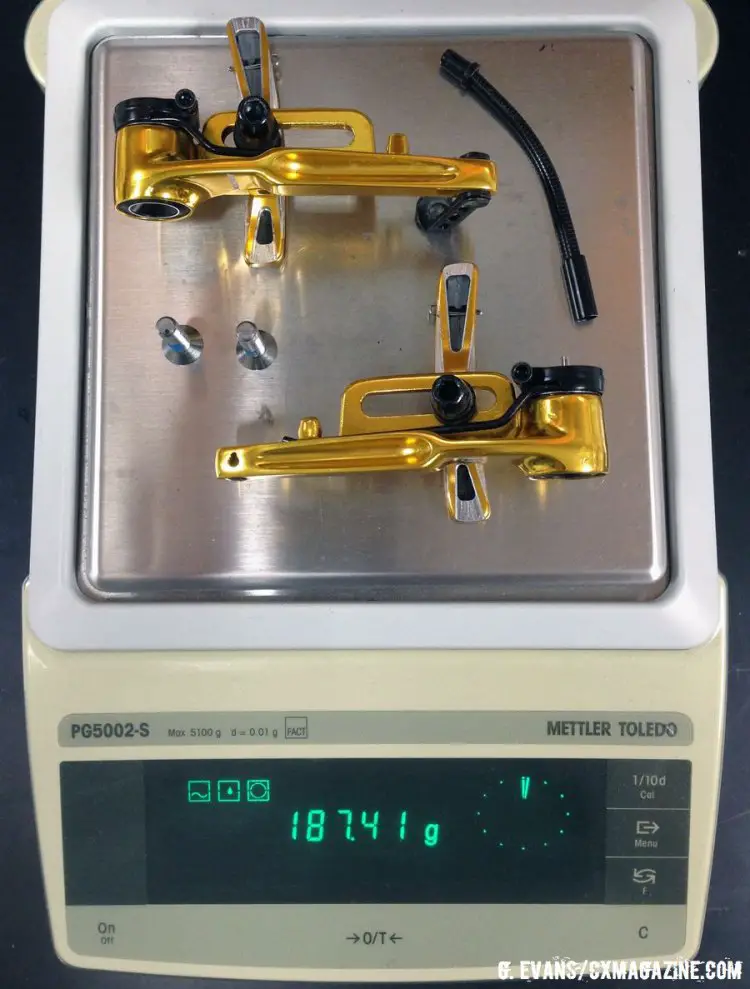Advertisement
by Greg Evans
Cyclocross brakes come in three predominant types: cantilevers, disc brakes, and mini-v’s (technically called mini-linear pull). The godfather of ‘cross bike binders is the cantilever-style which, despite lacking all-out power, remains popular on the Euro race circuit for their light weight, reliability, and clearance for mud. (If you’re in the canti camp, make sure you’re getting the most out of them.) The newest contender, the hydraulic disc brake, is certainly on its way to dominance, now coming as standard equipment on many new ‘cross bikes.
Somewhere in the middle, lies the mini-v. The stubby sibling to v-brakes, (found on mountain bikes of yore) has become a popular option for riders who are still running frames with canti posts. Mini-v’s often offer improved braking performance over cantis. But the mini-v’s tolerance for mud is notoriously low, because to work effectively the pads need to run close to the rim so that the shorter cable pull of road-style levers will still provide enough movement to contact the rim without the lever bottoming out. For this reason, the brakes are a more popular choice amongst riders who experience mostly dry conditions.
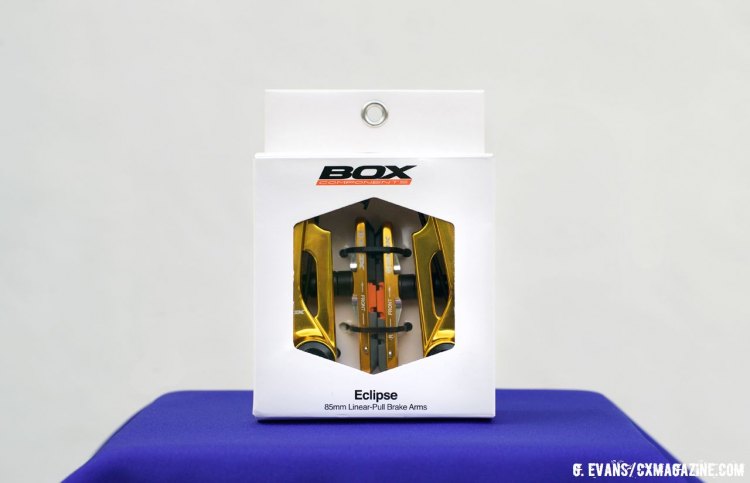
The Box Eclipse Brakes come neatly packaged with considerate details like a metal grommet that reinforces the hook eyelet. © G. Evans/Cyclocross Magazine
While mini-v’s are not necessarily new tech, with offerings from TRP and Tektro (to name a few) having been on the market for years now, the brakes reviewed here, the Box Components Eclipse mini-v, are the debut mini-linear pull brake offering from a brand that is also relatively new.
Founded in 2011, Box Components wasted no time in churning out products, and now offer a full range of bits and pieces ranging from hubs and wheels to derailleurs and cranksets. Box Components positions itself as a brand that strives to engineer the stiffest and lightest products available. They produce components for BMX and mountain bikers alike, so when they offered up a product for ‘cross riders, although originally intended for BMX, we were definitely intrigued.
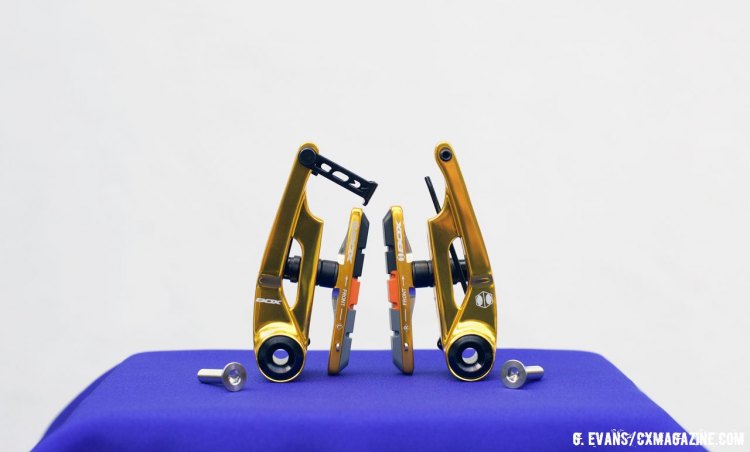
The brake arms are cold-forged from 6061-T6 aluminum in an effort to improve stiffness and shave weight. © G. Evans/Cyclocross Magazine
Included in each package is a set of brake arms, fitted with Box’s own X-Ray brake shoes and pads, as well as titanium mounting bolts and a flexible brake noodle. Right out of the box, the gold anodized finish is the first thing to catch the eye. These things are bright enough to make King Midas blush! As the gold brakes shined before my eyes, I could almost swear I heard Samuel L. asking me if I was happy.
The brake arms are cold-forged from 6061-T6 aluminum, a process that Box claims results in a stiffer and lighter component that has more durability than a piece that has been cnc machined. To put this in perspective, TRP’s largely successful CX9 and CX8.4 brakes are also forged, but feature cnc machining throughout. The Eclipse’s two brake arms show no signs of machining, giving them a smooth and rounded appearance. The laser-etched graphics are a nice touch as well, and are likely to remain fresh for many seasons.
I must stress the beefiness of these brake arms. Their stout build seems impervious to flex, and my seatstays bow outward long before the brakes show even a hint of give.
When first installing the brakes, I noticed that the titanium mounting bolts sit flush with the face of the brake arms. This attention to detail is appreciated, as this feature gives the brake a modern, stylish look.
Upon running the cable, I used the flexible brake noodle that came with the set. It guided the cable through a nice, consistent curve that would have left your calculus teacher itching to find the derivative. I would have preferred a cable with a barrel adjuster, but, the Eclipse brakes are intended for use on BMX bikes as well, in which case the lever would be equipped with a barrel adjuster. Since I was pairing the brakes to a set of STI levers, I opted to cut my housing and installed an inline adjuster beforehand. Had I not done this, it would have been tough to get the brakes tight enough while still being able to undo the brake for wheel removal.
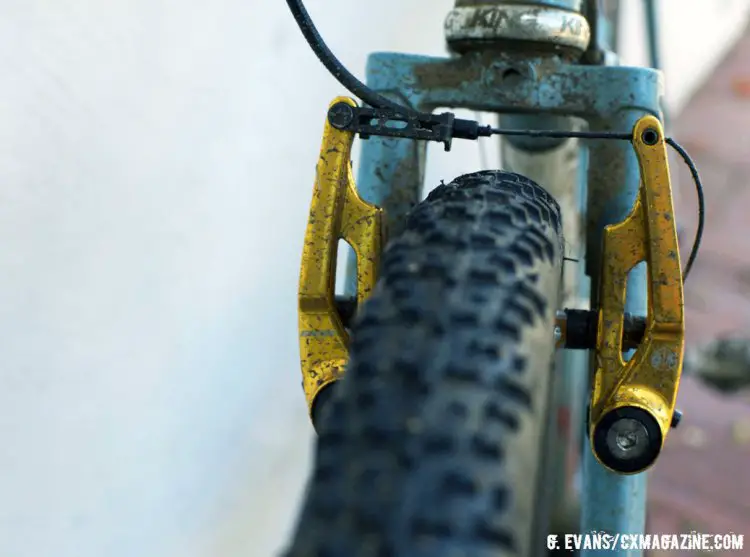
The 85mm brake arms offer substantial mud clearance around the tire. However, like other mini-v brakes the pad and pad-holder run very close to the rim, allowing for easy gunk buildup. © G. Evans/Cyclocross Magazine
The brakes feature an integrated 2.5mm cinch bolt for clamping the cable. This is a nice feature aesthetically, and while it likely saves a bit of weight, it did have a knack for chewing up the cable when really tightened down. This can be problematic when re-bolting the cable after initial cable stretch. I can imagine the fraying that would occur if a barrel adjuster were not installed and the clamp needed to be undone for wheel removal. Inflating the tire after installation would eliminate this problem, however it would not be ideal in a pit scenario during a race.
Next I set the pads. Box supplies their own triple-compound brake pads, done up in a tri-tone color scheme. The pads are housed in the Box X-Ray brake shoes, which are also cold forged, but feature machined cutouts in an X pattern—hence the name. The pad is fixed by way of a cotter pin rather than a screw because of the extensive machining to the pad holder. The finish on the brakes did seem to cause the threaded posts to want to drift slightly as I tightened them, so it took a bit longer to dial them in.
Balancing the brakes was a pleasant experience, as each arm features a 3mm bolt for spring tension adjustment. The thread engagement is smooth, and there is virtually no chance of stripping the bolt head, a problem that can occur on the Phillips head tension bolts sometimes found on other v-brake sets. The adjustments have proven to be secure, as I haven’t needed to rebalance the pads since initial installation, despite extensive use on commutes and recreational rides, as well as a few stints at some local races.
The brakes offered a substantial amount of power, and the bite was achieved at a steady ramp-up. I rarely found myself unintentionally locking up the rear wheel, even under last-second braking to set up for a corner. This is not to say that the brakes couldn’t be locked up if necessary, they just don’t have the on-or-off intensity of some hydraulic disc brakes.
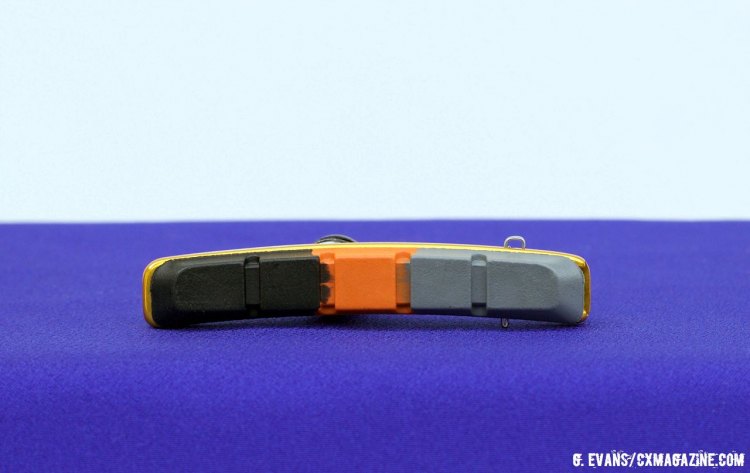
Box’s own triple-compound 70mm brake pads come in an eccentric tri-tone color scheme. © G. Evans / Cyclocross Magazine
The pads performed well in dry weather, although they changed their tune as soon as rain began to fall from the sky in the winter months. Braking power suffered slightly in wet conditions, more so than other all-weather pads that I have used in the past. But after three months of heavy use, and many encounters with mud and rain, the pads have worn only slightly.
I am currently running WTB Nano 40’s and Stans Alpha 340 rims which is a rather narrow rim/wide tire combination. I had to be very meticulous about pad placement, tucking it just under the bulbous tire for full brake track contact. While I don’t think I ever had any tire rub on the brake shoe, I have since replaced the pads with a set of Kool-Stop Thinlines—the same pads that come stock on the award-winning Paul Component mini-v’s—to give myself that tiny bit of extra space. This would be a non-issue for people running standard 33c tires, and a wider rim would likely remedy the problem for tires that have a bit more meat. I will note that the salmon compound on the new pads has improved the power of the brake.
What Box Components has brought to the market is a unique offering for those looking for stopping power on their ‘cross bikes. Available in four anodized colors, the brakes could certainly add some flair to a bike build. However, at $99 USD per brake, they are considerably more expensive than the majority of other mini-v brake sets. With a weight of 189 grams per brake, they are also not the lightest brakes around. Any gains of weight, however, are certainly made up for in stiffness.
Minor gripes aside, the brakes do work well, and finding a pad compound that works for you may make them work even better. The Eclipse brakes may be the right choice for riders looking for something that shines like gold, but is tough as nails.
Box Components Eclipse Mini-V Brakes
Weight: 189 grams (per brake)
MSRP: $99 USD (per brake)
More info: boxcomponents.com













